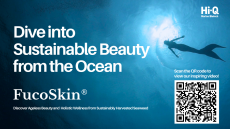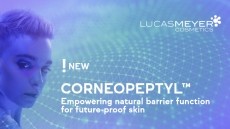“Competing companies must work together in a pre-competitive space.” Co-chair of the Sustainability Beauty Coalition

Cosmetics-DesignEurope: You’re the newly appointed co-chair of the Sustainability Beauty Coalition. Congratulations! What topics are currently on the agenda for the Coalition?
Mark Smith: “We’re continuing our focus on driving systematic change across the beauty industry when it comes to sustainability. Since the Coalition brings together actors from across the spectrum of the cosmetics industry, in a pre-competitive space, it’s the perfect place to pool ideas and stimulate real change. A top priority is waste and how to tackle this issue from a consumer, industry, and a policy perspective. To implement our actions, we’re harnessing the diverse expertise of the Coalitions’ Steering Committee and Advisory Committee.”
CDE: How are you working to tackle the issue of greenwashing?
Mark Smith: “Greenwashing is a core issue to address within the Coalition’s work. Consumers and industry need points of orientation in order to effect positive action. When the Coalition first started in 2021, we immediately created the Planet Positive Beauty Guide to time with COP26 climate change summit. The Guide is a living document for consumers, a tool that includes the various labels and claims related to ingredients, packaging, people, and sustainable sourcing, to ensure shoppers are making informed decisions and more sustainable consumption choices. We had already considered a similar means to provide our industry with guidance when we started, and as part of our focus on waste we expect to revisit this topic to ensure sustainable best-practices are implemented and greenwashing is avoided.”
CDE: What do you think is most important right now for the beauty and wellness industries in terms of sustainability?
Mark Smith: “Fundamentally, competing companies must work together in a “pre-competitive space”, which assists the drive towards measurable and meaningful impact through standardisation and points of orientation. This does not mean competition and innovation are irrelevant. It is more about generating a level playing-field first and foremost and ensuring that change is based upon scientific evidence and measurable impact. Trust and collective responsibility must be at the core of industry action right now, which may require refocusing of old-fashioned approaches to adapt to new needs.”
CDE: What do you think needs to change?
Mark Smith: “Collaboration is the key since a mindset to operate in isolation will not work. A transformative, circular economy approach from industry will also be necessary when considering any improvements to a sustainability profile need to cover impacts up and downstream. Avoiding the idea of ‘out of sight, out of mind’, particularly when it comes to traditionally disposable elements like packaging, will become critical given that how we manage resources influences what we make, how we use products, and ultimately what we do with those resources after their use.
There also need to be guarantees when it comes to transparency and traceability for any set of defined characteristics throughout the supply chain to ultimately ensure claims are substantiated. This approach could also mean ensuring third-party verification for independence, and additional trust and reassurance.”
CDE: What new trends have you seen in terms of ingredients upcycling?
Mark Smith: “Upcycling can take many forms – from direct use of waste streams and by-products to further transformation of those same products into valuable new materials. The combination of valorisation of waste and innovation to develop new methods for processing and extraction – whether using traditional, new state-of-the-art, biotechnological methods or a combination – represents an exciting new science-driven interface to drive improved sustainability.
There is a long list of novel approaches. In fact, some recent examples include finding new life and new uses for certified organic but non-food oils, which would ordinarily be considered waste in cosmetics; use of Baobab fruit pulp, a by-product of the organic baobab oil production; or upcycling used waste coffee grounds into new aromatics.”
CDE: Have you recently seen anything notable in terms of sustainable packaging trends?
Mark Smith: “Making packaging sustainable is not easy. To reduce waste, one of the most common trends in recent years has been to formulate waterless products where possible, to minimise packaging to simply provide the fundamental requirements. Although some brands are able to source post-consumer recycled plastics for reuse, their availability and price are often factors that negatively impact smaller businesses.
In a drive to reduce waste, we are gradually seeing more traction in refillable or prefilled reusable packaging to significantly lower our dependence on virgin plastic materials, and therefore the CO2 footprint. When it comes to the sustainable production of packaging materials themselves, we have seen developments in material science to capture resources, like carbon dioxide for repurposing, or engineering new packaging-purposeful raw materials from microorganisms.”
CDE: What ‘green and clean’ beauty trends do you expect to see in the future?
Mark Smith: “In respect of improved sustainability, a general movement away from fossil fuel to renewable raw materials has already started. Equally, we can foresee companies taking ever more holistic approaches to the impact of their products by taking into account the life-cycle of the ingredients, the product and its packaging. Ideally, all botanical and inorganic raw materials would ensure verified sustainable and ethical sourcing. Validation by third-party certification is also conceivable – especially with on-going discussions on green claims in the EU.
The traditional perception of a natural ingredient may be challenged by sustainable ingredients derived from the conversion of waste stream gases like CO2 from industrial production into repurposed derivatives.
“Finally, increased use of upcycled ingredients and products from microbial and enzymatic fermentation are also expected to increase in the drive to reduce the environmental footprint for any given ingredient, and ultimately the products it is used in.”
CDE: Anything else you’d like to add?
Mark Smith: For anyone who is interested in learning more about the Sustainable Beauty Coalition, we’d love to hear from you. From NATRUE’s side, on 23rd November we’ll be holding our annual International Day of Natural Cosmetics to inspire and motivate both the industry and its consumers about natural and sustainable beauty.




























